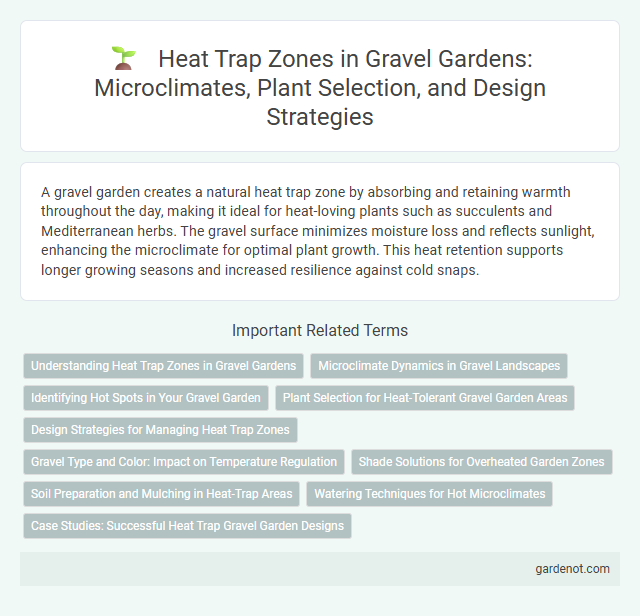A gravel garden creates a natural heat trap zone by absorbing and retaining warmth throughout the day, making it ideal for heat-loving plants such as succulents and Mediterranean herbs. The gravel surface minimizes moisture loss and reflects sunlight, enhancing the microclimate for optimal plant growth. This heat retention supports longer growing seasons and increased resilience against cold snaps.
Understanding Heat Trap Zones in Gravel Gardens
Heat trap zones in gravel gardens are microclimates created by heat-absorbing materials like stones and pebbles that retain warmth and reflect it back to plants. These zones support heat-loving species such as sedums, succulents, and Mediterranean herbs by providing consistent warmth and reducing frost risk. Proper placement and plant selection within heat trap zones optimize growth and enhance the garden's microecological balance.
Microclimate Dynamics in Gravel Landscapes
Gravel gardens create heat trap zones by absorbing and radiating solar energy, influencing microclimate dynamics within the landscape. This thermal retention raises soil temperatures, promoting extended growing seasons for heat-tolerant plants and aiding in moisture conservation. Understanding these microclimate effects is essential for optimizing plant selection and garden design in gravel-dominated environments.
Identifying Hot Spots in Your Gravel Garden
Heat trap zones in gravel gardens often occur in areas with dark-colored stones that absorb and retain solar radiation, creating localized hot spots. These zones can cause stress to heat-sensitive plants by elevating soil temperature and reducing moisture levels. Identifying these hot spots involves monitoring soil temperature and observing plant health patterns to adjust plant selection and irrigation strategies effectively.
Plant Selection for Heat-Tolerant Gravel Garden Areas
Plant selection for heat-tolerant gravel garden areas focuses on species that thrive in heat trap zones where temperatures are elevated due to sun-reflecting gravel surfaces. Succulents like sedum, agave, and aloe, along with drought-resistant herbs such as lavender and thyme, are ideal for these conditions due to their ability to store water and withstand intense heat. Choosing native heat-adapted perennials ensures resilience and reduces maintenance, making the gravel garden both sustainable and vibrant.
Design Strategies for Managing Heat Trap Zones
Design strategies for managing heat trap zones in gravel gardens include incorporating shade trees and deciduous shrubs to reduce intense solar radiation and lower ambient temperatures. Utilizing light-colored or reflective gravel materials minimizes heat absorption and prevents excessive soil warming. Integrating permeable surfaces and strategic plant placement enhances airflow, effectively dissipating trapped heat and maintaining a balanced microclimate.
Gravel Type and Color: Impact on Temperature Regulation
Gravel type and color significantly influence temperature regulation in heat trap zones within gravel gardens, as darker gravel absorbs and retains more heat compared to lighter, reflective varieties. Coarse-textured gravel allows better airflow and cooler surface temperatures, while fine, compacted gravel traps heat, creating localized warm microclimates. Selecting gravel with appropriate thermal properties enhances plant resilience and supports optimal growth conditions in heat-intensive garden areas.
Shade Solutions for Overheated Garden Zones
Heat trap zones in gravel gardens often experience intensified temperatures that stress plants and degrade soil quality. Implementing effective shade solutions such as strategically placed shade cloths, pergolas, or drought-tolerant shrubs can significantly reduce heat absorption and protect delicate garden areas. Utilizing these shading techniques enhances plant health while maintaining the garden's aesthetic appeal and sustainability.
Soil Preparation and Mulching in Heat-Trap Areas
In heat trap zones of gravel gardens, thorough soil preparation is crucial to enhance water retention and root aeration, often involving the incorporation of organic matter and sand for optimal drainage. Mulching with light-colored gravel or small stones helps reflect sunlight, reduces soil temperature, and conserves moisture, creating a more stable microenvironment for heat-sensitive plants. Proper soil amendment combined with strategic mulching techniques boosts plant resilience and promotes sustained growth in these high-temperature garden areas.
Watering Techniques for Hot Microclimates
In gravel gardens located within heat trap zones, precise watering techniques optimize plant survival and growth by reducing water evaporation and promoting deep root hydration. Employ drip irrigation systems and mulch around plant bases to maintain soil moisture and control temperature fluctuations. Scheduling watering during early morning or late evening hours ensures maximum water absorption and minimizes stress on plants exposed to intense heat.
Case Studies: Successful Heat Trap Gravel Garden Designs
Case studies of successful heat trap gravel garden designs demonstrate how strategically placed gravel beds absorb and retain solar heat, creating microclimates ideal for heat-loving plants like succulents and Mediterranean herbs. These heat trap zones enhance plant growth by increasing soil temperature and reducing moisture evaporation, as seen in gardens from arid regions such as the American Southwest and Mediterranean coast. Data reveals a 20-30% increase in temperature retention in gravel zones, promoting extended growing seasons and drought resilience.
Heat trap zone Infographic

 gardenot.com
gardenot.com